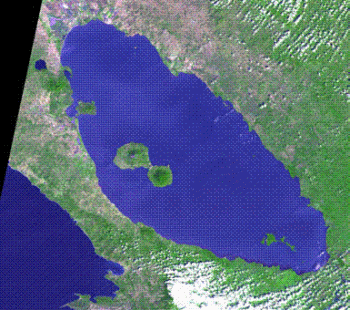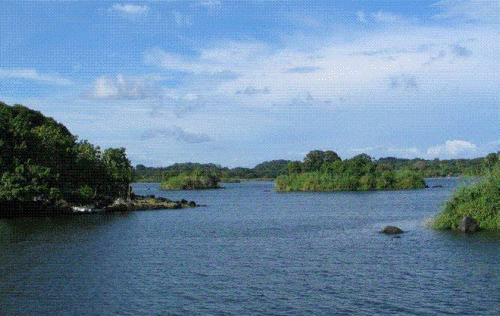 SKC Films Library SKC Films Library |
|
|
| SKC Films Library
>> American History
>> Central America
>> Nicaragua |
| Lake Nicaragua Known as Cocibolca by indigenous peoples and La Mar Dulce (the Sweet Sea) by Spanish conquerors, Lake Nicaragua is the second largest freshwater lake in Latin America, behind Lake Titicaca. Covering 3,191 square miles, the lake is so big that it is subject to large waves and heavy storms. satellite view of Lake Nicaragua Geologists believe the lake was once a bay of the Pacific Ocean that was cut off from the sea by repeated volcanic eruptions. The lake has an average depth of 43 feet, and a maximum depth of 148 feet. It is fed by numerous rivers. Its only outflow is the San Juan River, which connects the lake to the Caribbean Sea. It is connected to Nicaragua's second largest lake, Managua, by the Tipitapa River. Lake Nicaragua is dotted with hundreds of islands and islets, some of them large enough to sport small cities. Major islands include Ometepe and Zapatera, and notable archipelagos include the Granada (365 islets) and Solentiname (36 islands). Most of the islands are tree-covered and have a tropical-like climate, but some are almost barren and dry. part of the island archipelago
within Lake Nicaragua Over 40 species of fish are found in Lake Nicaragua, including 16 species of cichlids alone. In addition to typical lake fish such as bass, salmon and trout, the lake is also home to three species of fish more commonly found in saltwater -- the Caribbean bull shark (Carcharhinus leucas), big sawfish (Pristis perotteti), and fine-toothed sawfish (Pristis pectinatus). Granada, on the northwestern shore of Lake Nicaragua, was the first city established in mainland America, in 1524. Other major cities on the lake are San Carlos, San Jorge, and San Miguelito. |
SKC Films Library >> American History >> Central America >> Nicaragua This page was last updated on 04/10/2017. |

